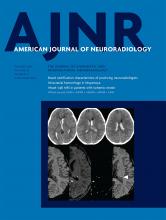Index by author
Lei, J.
- Adult BrainOpen AccessCerebral Damage after Carbon Monoxide Poisoning: A Longitudinal Diffusional Kurtosis Imaging StudyY. Zhang, T. Wang, J. Lei, S. Guo, S. Wang, Y. Gu, S. Wang, Y. Dou and X. ZhuangAmerican Journal of Neuroradiology October 2019, 40 (10) 1630-1637; DOI: https://doi.org/10.3174/ajnr.A6201
Levy, M.
- LetterYou have accessReply:E. Bulut, J. Karakaya, S. Salama, M. Levy, T.A.G.M. Huisman and I. IzbudakAmerican Journal of Neuroradiology October 2019, 40 (10) E62; DOI: https://doi.org/10.3174/ajnr.A6216
Li, D.
- FELLOWS' JOURNAL CLUBAdult BrainOpen AccessCerebral Venous Thrombosis: MR Black-Blood Thrombus Imaging with Enhanced Blood Signal SuppressionG. Wang, X. Yang, J. Duan, N. Zhang, M.M. Maya, Y. Xie, X. Bi, X. Ji, D. Li, Q. Yang and Z. FanAmerican Journal of Neuroradiology October 2019, 40 (10) 1725-1730; DOI: https://doi.org/10.3174/ajnr.A6212
Twenty-six participants underwent conventional imaging methods followed by 2 randomized black-blood thrombus imaging scans, with a preoptimized DANTE preparation switched on and off, respectively. The signal intensity of residual blood, thrombus, brain parenchyma, normal lumen, and noise on black-blood thrombus images were measured. The thrombus volume, SNR of residual blood, and contrast-to-noise ratio for residual blood versus normal lumen, thrombus versus residual blood, and brain parenchyma versus normal lumen were compared between the 2 black-blood thrombus imaging techniques. The new black-blood thrombus imaging technique provided higher thrombus-to-residual blood contrast-to-noise ratio, significantly lower thrombus volume, and substantially improved diagnostic specificity and agreement with conventional imaging methods.
Li, T.
- EDITOR'S CHOICENeurointerventionOpen AccessSafety and Efficacy of Transvenous Embolization of Ruptured Brain Arteriovenous Malformations as a Last Resort: A Prospective Single-Arm StudyY. He, Y. Ding, W. Bai, T. Li, F.K. Hui, W.-J. Jiang and J. XueAmerican Journal of Neuroradiology October 2019, 40 (10) 1744-1751; DOI: https://doi.org/10.3174/ajnr.A6197
Twenty-one consecutive patients with ruptured brain AVMs who underwent transvenous embolization were prospectively followed between November 2016 and November 2018. Complete AVM nidus obliteration was shown in 16 (84%) of 19 patients. One (5%) patient with a small residual nidus after treatment showed complete obliteration at 13-month follow-up. There were 5 hemorrhages and 1 infarction; 4 patients' symptoms improved gradually. Transvenous embolization can be performed only in highly selected hemorrhagic brain AVMs with high complete obliteration rates, but it should not be considered as a first-line treatment.
Li, T.-F.
- NeurointerventionOpen AccessApplication of High-Resolution C-Arm CT Combined with Streak Metal Artifact Removal Technology for the Stent-Assisted Embolization of Intracranial AneurysmsT.-F. Li, J. Ma, X.-W. Han, P.-J. Fu, R.-N. Niu, W.-Z. Luo and J.-Z. RenAmerican Journal of Neuroradiology October 2019, 40 (10) 1752-1758; DOI: https://doi.org/10.3174/ajnr.A6190
Li, X.
- Adult BrainOpen AccessLateral Posterior Choroidal Collateral Anastomosis Predicts Recurrent Ipsilateral Hemorrhage in Adult Patients with Moyamoya DiseaseJ. Wang, Y. Yang, X. Li, F. Zhou, Z. Wu, Q. Liang, Y. Liu, Y. Wang, S. Na, X. Chen, X. Zhang and B. ZhangAmerican Journal of Neuroradiology October 2019, 40 (10) 1665-1671; DOI: https://doi.org/10.3174/ajnr.A6208
Liang, Q.
- Adult BrainOpen AccessLateral Posterior Choroidal Collateral Anastomosis Predicts Recurrent Ipsilateral Hemorrhage in Adult Patients with Moyamoya DiseaseJ. Wang, Y. Yang, X. Li, F. Zhou, Z. Wu, Q. Liang, Y. Liu, Y. Wang, S. Na, X. Chen, X. Zhang and B. ZhangAmerican Journal of Neuroradiology October 2019, 40 (10) 1665-1671; DOI: https://doi.org/10.3174/ajnr.A6208
Lichtenstein, T.
- Patient SafetyYou have accessVirtual Monoenergetic Images from Spectral Detector CT Enable Radiation Dose Reduction in Unenhanced Cranial CTR.P. Reimer, D. Flatten, T. Lichtenstein, D. Zopfs, V. Neuhaus, C. Kabbasch, D. Maintz, J. Borggrefe and N. Große HokampAmerican Journal of Neuroradiology October 2019, 40 (10) 1617-1623; DOI: https://doi.org/10.3174/ajnr.A6220
Liebig, T.
- NeurointerventionYou have accessLow-Profile Intra-Aneurysmal Flow Disruptor WEB 17 versus WEB Predecessor Systems for Treatment of Small Intracranial Aneurysms: Comparative Analysis of Procedural Safety and FeasibilityL. Goertz, T. Liebig, E. Siebert, M. Herzberg, L. Pennig, M. Schlamann, J. Borggrefe, B. Krischek, F. Dorn and C. KabbaschAmerican Journal of Neuroradiology October 2019, 40 (10) 1766-1772; DOI: https://doi.org/10.3174/ajnr.A6183
Liu, X.
- FELLOWS' JOURNAL CLUBAdult BrainYou have accessPerfusion MRI-Based Fractional Tumor Burden Differentiates between Tumor and Treatment Effect in Recurrent Glioblastomas and Informs Clinical Decision-MakingM. Iv, X. Liu, J. Lavezo, A.J. Gentles, R. Ghanem, S. Lummus, D.E. Born, S.G. Soltys, S. Nagpal, R. Thomas, L. Recht and N. FischbeinAmerican Journal of Neuroradiology October 2019, 40 (10) 1649-1657; DOI: https://doi.org/10.3174/ajnr.A6211
Forty-seven patients with high-grade gliomas (primarily glioblastoma) with recurrent contrast-enhancing lesions on DSC-MR imaging were retrospectively evaluated after surgical sampling. Histopathologic examination defined treatment effect versus tumor. Normalized relative CBV thresholds of 1.0 and 1.75 were used to define low, intermediate, and high fractional tumor burden classes in each histopathologically defined group. Performance was assessed with an area under the receiver operating characteristic curve. Mean low fractional tumor burden, high fractional tumor burden, and relative CBV of the contrast-enhancing volume were significantly different between treatment effect and tumor with tumor having significantly higher fractional tumor burden and relative CBV and lower fractional tumor burden. High fractional tumor burden and low fractional tumor burden define fractions of the contrast-enhancing lesion volume with high and low blood volume, respectively, and can differentiate treatment effect from tumor in recurrent glioblastomas. Fractional tumor burden maps can also help to inform clinical decision-making.








